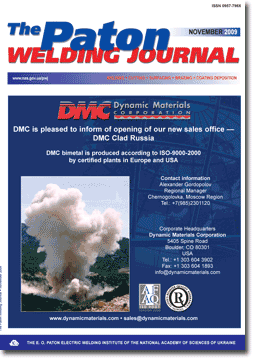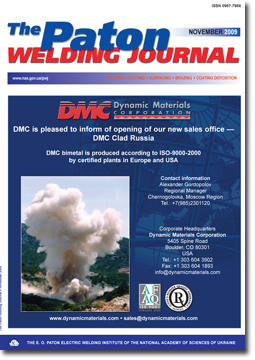| 2009 №11 (01) | 2009 №11 (03) |

TPWJ, 2009, #11, 12-15 pages
INFLUENCE OF DEFORMATION MECHANISM IN THE COLLISION ZONE OF MATERIAL PAIRS ON SELECTION OF OPTIMUM PARAMETERS OF EXPLOSION WELDING
Journal The Paton Welding Journal
Publisher International Association «Welding»
ISSN 0957-798X (print)
Issue № 11, 2009 (November)
Pages 12-15
Authors
M.P. BONDAR
M.A. Lavrentiev Institute of Hydrodynamics, RAS SD, Novosibirsk, RF
Abstract
The necessary condition for providing a strong joint between the bodies in a region of the lower boundary of explosion welding is formation of a zone of intensive plastic deformation with a localization band along the joint interface. The mechanisms of formation of bands of plastic deformation localization (BPDL) under high-velocity loading depend on grain size of initial materials. It is shown that initiation of BPDL in a coarse-grained material occurs at ε = 0,2...0,3 and is related to loss of shear stability. There is a certain critical grain size dкр, starting from which the prevailing deformation mechanism is slipping along the grain boundaries, like in a nanocrystalline material. Being a result of rotation instability, in a fine-grained material BPDL are formed at high velocities and deformations of ε′ > 104 c-1 and ε ≤ 2.
Keywords: explosion welding, grain size, high-rate deformation of metals, deformation mechanism, plastic deformation, slipping
Received: ??
Published: 28.11.09
References
1. Sedykh, V.S. (1985) Classification, evaluation and interrelation of the main parameters of explosion welding. In: Transact, of Higher Education Institutions on Explosion Welding and Properties of Welded Joints. Volgograd: VolgPI.
2. Lysak, V.I., Kuzmin, S.V. (2005) Explosion welding. Moscow: Mashinostroenie.
3. Oberg, A., Martensoon, N., Shweitz, J.A. (1985) Fundamental aspects of formation and stability of explosive welds. Metallurgical Transact. A, 16, 841-851.
4. Deribas, A.A., Zakharenko, I.D. (1973) On surface effects at glancing collisions of metal plates. Fizika Goreniya i Vzryva, 10(3), 409-423.
5. Zakharenko, I.D. (1979) On prerequisites for explosion welding. Ibid., 8(3), 422-428.
6. Bondar, M.P., Ogolikhin, V.M. (1985) About plastic deformation in explosion welding joint zone. Ibid., 21 (2), 147-51.
7. Bondar, M.P. (1995) Type of localization of plastic deformation on contacts determining the formation of bonding. Ibid., 31(5), 122-128.
8. Bondar, M.P., Nesterenko, V.F. (1991) Deformation on contacts and criteria of joint formation in pulse actions. Ibid., 27(3), 103-117.
9. Nesterenko, V.F., Bondar, M.P. (1994) Localization of deformation at collapse of thick-wall cylinder. Ibid., 30(4), 99-111.
10. Bondar, M.P., Merzhievsky, L.A. (2006) Evolution of metal microstructure and conditions of deformation localization at high-rate loading. Ibid., 42(3), 121-131.
11. Tyumentsev, A.N., Ditenberg, I.A., Pinzhin, Yu.P. et al. (2003) Peculiarities of microstructure and mechanisms of formation of submicrocrystalline copper made by methods of intensive plastic deformation. Fizika Metallov i Metallovedenie, 96(4), 33-43.
12. Gleiter, H. (1981) Materials with ultrafine grain size. In: Proc. of 2nd Int. Symp. on Metallurgy and Materials Science (Denmark), 15-21.
Suggested Citation
M.P. BONDAR (2009) INFLUENCE OF DEFORMATION MECHANISM IN THE COLLISION ZONE OF MATERIAL PAIRS ON SELECTION OF OPTIMUM PARAMETERS OF EXPLOSION WELDING. The Paton Welding J., 11, 12-15.The cost of subscription/purchase order journals or individual articles
| Journal/Currency | Annual Set | 1 issue printed |
1 issue |
one article |
| TPWJ/USD | 384 $ | 32 $ | 26 $ | 13 $ |
| TPWJ/EUR | 348 € | 29 € | 24 € | 12 € |
| TPWJ/UAH | 7200 UAH | 600 UAH | 600 UAH | 280 UAH |
| AS/UAH | 1800 UAH | 300 UAH | 300 UAH | 150 UAH |
| AS/USD | 192 $ | 32 $ | 26 $ | 13 $ |
| AS/EUR | 180 € | 30 € | 25 € | 12 € |
| SEM/UAH | 1200 UAH | 300 UAH | 300 UAH | 150 UAH |
| SEM/USD | 128 $ | 32 $ | 26 $ | 13 $ |
| SEM/EUR | 120 € | 30 € | 25 € | 12 € |
| TDNK/UAH | 1200 UAH | 300 UAH | 300 UAH | 150 UAH |
| TDNK/USD | 128 $ | 32 $ | 26 $ | 13 $ |
| TDNK/EUR | 120 € | 30 € | 25 € | 15 € |
AS = «Automatic Welding» - 6 issues per year;
TPWJ = «PATON WELDING JOURNAL» - 12 issues per year;
SEM = «Electrometallurgy Today» - 4 issues per year;
TDNK = «Technical Diagnostics and Non-Destructive Testing» - 4 issues per year.


